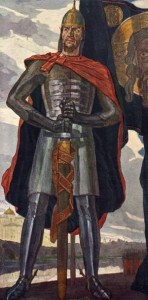What are the sources for Belisarius?
 Listener Steve asked what (excluding Procopius) are the sources- Byzantine or otherwise- for the life and career of Belisarius?
Listener Steve asked what (excluding Procopius) are the sources- Byzantine or otherwise- for the life and career of Belisarius?
The good news is that there were a lot of historians and chroniclers active during Belisarius’ lifetime, and most of them were aware that they were living through significant times. Procopius stopped writing in 552 and was continued by Agathias Scholasticus till the year 588. He was in turn followed by a man named Menander Protector who decided to write history after he had blown his life savings having a good time. This was evidently a smart career choice as Menander was soon joined by a crowd of writers. If you fancied Justinian’s reign you could pick up bestsellers from Evagrius, John of Epiphaneia, John Malalas, and Marcellinus Comes.
The bad news, however, is that most of these are only partially translated today- or worse exist only in fragments. Unless you know someone at Dumbarton Oaks, you’re probably not going to be able to read them anytime soon. The only commercially available, non-Procopius source is Jordanes. He was a 6th century Roman bureaucrat who had a book collection and the rare gift (as he put it) of being concise. A friend who wanted to read a history of the Goths asked to borrow a copy of Cassiodorus’ (now lost) work, but when he saw its size (12 volumes) he asked Jordanes to sum it up for him. The result is the Getica, which concludes with Belisarius’ brilliant defeat of the Goths in 540.
[…] This post was mentioned on Twitter by Anders Brownworth, Lars Brownworth. Lars Brownworth said: How do we know about Belisarius? http://www.larsbrownworth.com/blog/?p=186 […]
The picture is wrong… Alexander Nevskii, the Duke of Novgorod is shown here…
I was trying to get away with one here. Rather than reuse the questionable image from Ravenna (that may or may not be Belisarius) or the François-André Vincent painting of him as an old man, I was trying to find an image of a warrior in full strength. I figured that given the Byzantine influence on Novgorod, Nevskii could fit the bill…
Lars: I had asked the original question on sources, other than Procopius, for the life and times of Belisarius. I was interested in learning more about those Ravenna mosaics, and their provenance, especially as relates to Belisarius. Certainly the image of the great general could be him from real life (standing at the right-hand of Justinian; young, handsome, an engaging look and powerful eyes that radiate intelligence; the image of Justinian appears to closely resemble others of the Emperor from various independent sources, such as the coins minted during his reign), but what do we actually know about the construction of the mosaics (when, by whom, the sources they used, etc.)? Would there happen to be any drawings or descriptions of those many statues of Belisarius still standing in Constantinople as of 1204? Did any artist or other citizen leave any images of the general (that have survived) at any time from the 6th Century until the fall of the city to the Turks? Etc.
Thanks for any additional information . . .
Steve